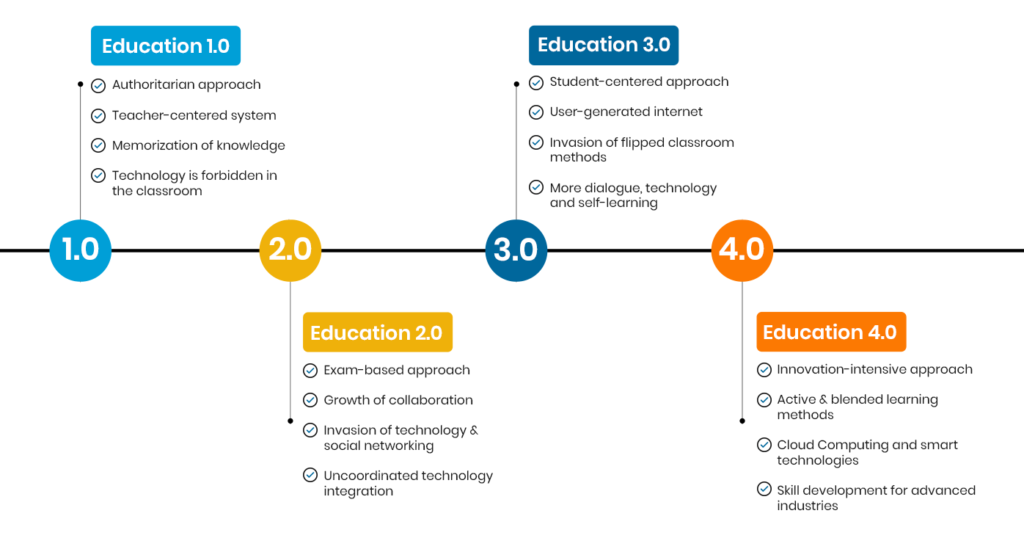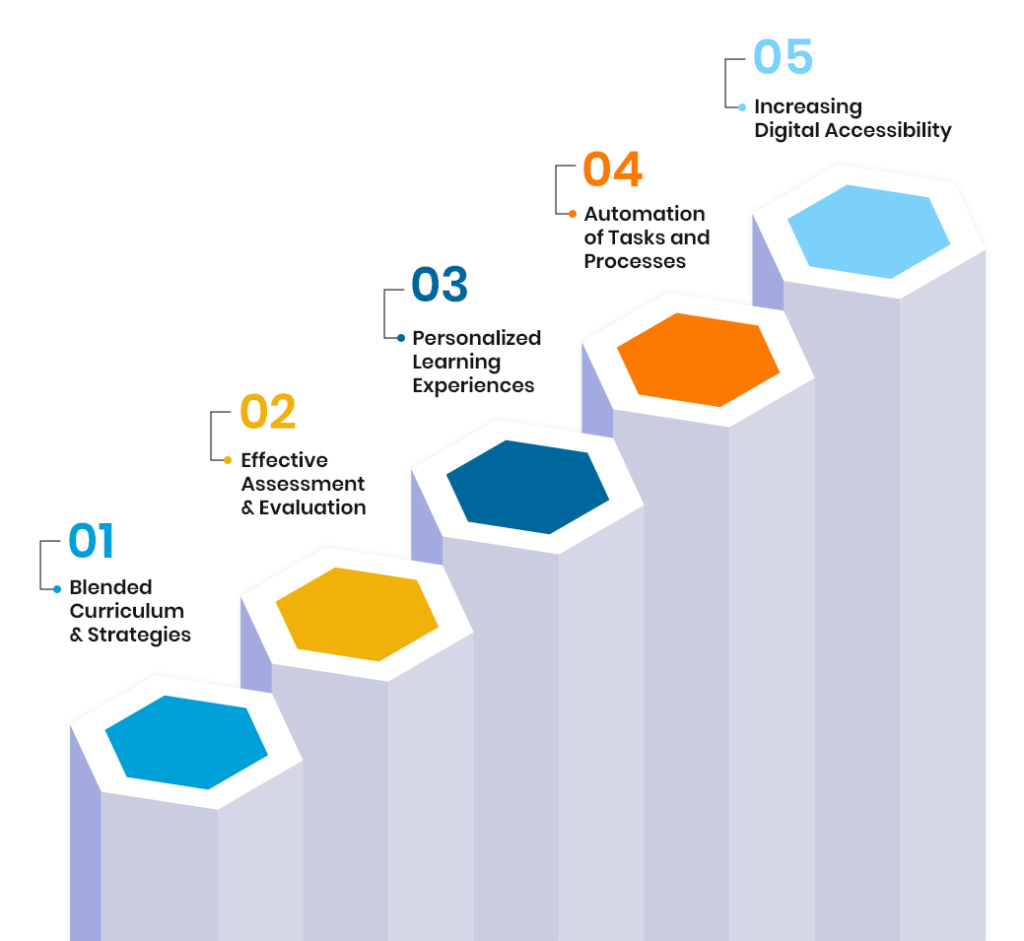Building a Strong Foundation: The Five Pillars of Digital Education 4.0
As a result of the pandemic, the educational landscape underwent a drastic and forced transformation. Teachers were compelled to use technology to establish a digital learning environment. Although traditional educational philosophies can deliver effective learning outcomes, they need to be revisited from a futuristic viewpoint in order to stay relevant.
Digital education with modern technologies and cloud-based platforms has the potential to enhance teaching and learning experiences, facilitating a new age of education that can be aligned with the needs of the 21st-century job landscape. To ensure learning advancement and to better prepare students for jobs in evolving industries, the educational system can model itself after businesses and enterprises with modern technology and digital platforms.
Evolution of the education industry:

- Education 1.0: Unidirectional dissemination of knowledge from the educators to the student in physical classrooms, focused around traditional lectures, notes, and memorization.
- Education 2.0: Technology started to infiltrate the educational process, and both teachers and students started using it in fundamental ways.
- Education 3.0: Utilization of a more user-generated internet, access to information resources, capacity for digital learning, and platforms for communication with instructors and other students.
- Education 4.0: A learning and teaching approach that is aligned with the fourth industrial revolution and focuses on transforming education through cutting-edge technology and automation. This technological revolution includes cloud-based platforms, artificial intelligence, smart technologies, and blended learning pedagogies. If universities want to stay competitive and churn out successful graduates, it is important to prepare the students for a world where cyber-physical systems are pervasive in all sectors of the economy. Technology integration, digital content creation, personalized learning experiences, effective evaluation, and innovative teaching strategies are some of the key factors to be considered for the success of the Education 4.0 initiative.
For a more detailed overview of the Education 4.0 initiative, click here
In this article, we’ll discuss the 5 pillars of Education 4.0. So, without further ado, let’s begin.
The 5 Pillars of Education 4.0

- Blended Curriculum for Evolving Industries
Employee skill requirements will undoubtedly and continuously change as cyber-physical systems are more fully incorporated into various industries. According to research by McKinsey Digital, 60% of all jobs in the fourth industrial revolution could automate at least a third of all tasks.
The ability of technology to keep us connected at all times has led to an increase in the flexibility and adaptability of job duties. Education 4.0 is all about adapting to changes, and for institutions of higher education, that means determining what their prospective graduates will need in the ever-evolving future.
This aspect of the education 4.0 can be successfully achieved with the systematic integration of digital content and digital platforms into the existing curriculum.
Digital content plays a significant part in this, allowing institutions to design, develop and distribute bespoke content repositories with multimedia content for delivering immersive learning experiences. Additionally, digital platforms can facilitate blended learning pedagogies, instilling continuity in the learning experience and increasing overall knowledge retention.
- Effective Assessment and Evaluation
Educators can strategize new techniques and optimize learning outcomes by integrating digital platforms into the classroom, which also makes the learning experience more exciting and engaging for the students. Immediate feedback is advantageous for students because it helps them rectify misconceptions and mistakes, and identify strengths and areas for improvement.
Digital learning can facilitate the use of data to better analyze a student’s progress and bridge learning gaps simultaneously. Blended learning pedagogies, facilitated through digital platforms, allow educators to stay connected with the students and provide guidance and feedback throughout the learning process.
Effective self-evaluation is another major benefit of digital education, students can access practice questions and assignments to better understand complex concepts and increase confidence in the gained knowledge.
- Personalized Learning Experiences
The goal of personalized learning is to tailor instruction to the unique needs, interests, and skills of each student. Each student receives a learning strategy that is based on their prior knowledge and preferred learning styles.
This pillar of Education 4.0 is a by-product of assessment and evaluation, offering valuable data to strategize teaching processes in such a way that benefits each student optimally. Additionally, a digital platform can facilitate this pillar seamlessly, allowing the educators to monitor each student’s progress through online assessment, making it easier to understand individual knowledge gaps and learning pace.
Above-average students who can perform at a higher level, teachers can provide more challenging assignments to hasten their progress. Students who struggle with a subject have the opportunity to revise and practice more until they reach the desired level, enabling a self-paced yet supervised learning environment.
- Automation of Tasks & Processes
Educators can reclaim enormous amounts of their valuable time by automating mundane tasks that are frequent and repetitive. Automation plays a key role in taking the education industry to the next level, reducing costs, and making lives easier for educators.
Additionally, automated features can enhance the learning experience for students as well. Automatic grading can facilitate instant self-evaluation and features like AI-powered chatbots can answer questions and provide basic feedback whenever required.
Administrative work takes up a considerable amount of time for teachers. For instance, the use of machine learning and artificial intelligence in education can help to automate tasks like assessment and grading. This enriches learning experiences by allowing educators to devote more time to the students.
Teaching processes that can be automated:
- Student onboarding
- Student grading
- Attendance tracking
- Scheduling classes
- Audits and compliance
- Back-office processes
And more.
- Increasing Digital Accessibility
In education, accessibility does not only apply to the information shared or taught. It is about allowing each student to have a similarly enriching experience and to demonstrate their knowledge. To engage people with different abilities, cultures, and languages, inclusivity is crucial.
Cloud-based digital platforms can be integrated with classroom learning to make education accessible to all students. It can assist students to overcome geographical limitations, facilitating limitless access to digital education.
Similar to the first pillar, digital content creation can be used to achieve this pillar of education 4.0 too, allowing educators to deliver online courses across the globe. People can earn their desired degree from their preferred school without moving, thanks to a digital education landscape that allows students to attend classes and submit assignments online. Additionally, it increases access to education for people with disabilities or health issues who might have trouble getting to and navigating campus.
In a nutshell,
Adapting learning experiences and teaching techniques to the needs of the 21st century demands the incorporation of digital education that includes advanced technologies and cloud-based platforms. It emphasizes the significance of empowering students to confront and solve real-world problems.
In addition to being guided rather than instructed and given access to knowledge rather than being spoon-fed, learners should be able to grasp the skills needed by rapidly evolving technology. The goal of education should be to equip students with the skills necessary to compete in the modern labor market.
The education industry must evolve with the rest of the world to produce the innovators and world-changers of tomorrow, and that’s the sole purpose of Education 4.0.
DigitalEd India is here to bolster and uplift the Education 4.0 initiative and provide seamless STEM education across the globe with its Möbius platform.
Here’s how Möbius implements the 5 pillars of Education 4.0:
- A blended learning environment where STEM students can leverage an interactive digital platform to revise and retain knowledge learned in the physical classroom.
- STEM educators can add a wide array of inline questions in-between lessons for effortless assessment. Also, students have access to algorithmically randomized questions for effective self-evaluation.
- Educators gain precise insights into students’ progress and knowledge gaps while conducting digital STEM courses on Möbius, enabling individualized suggestions and feedback.
- The learning/teaching experience is enriched with cutting-edge automation features like randomized questions and grading, allowing educators to focus on optimizing learning outcomes.
- Educational institutions and universities can create extensive online content repositories and offer STEM courses without any geographical boundaries.
Intrigued?
Get in touch for an in-depth product demo session.
And stay tuned for more weekly articles in the Education 4.0 series.